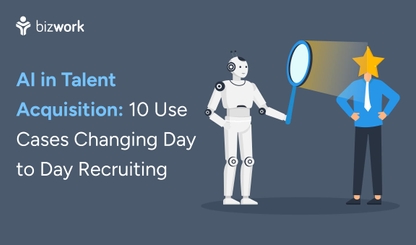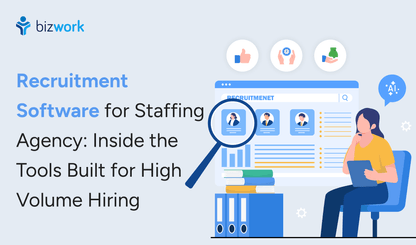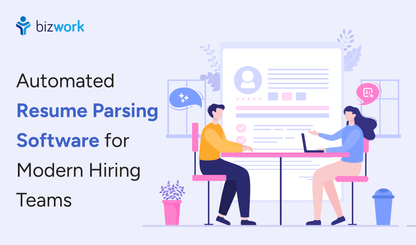Hiring has changed fast. Recruiters now rely on AI recruitment software and Applicant Tracking Systems (ATS) to scan resumes before they even open a single file. These tools decide who moves forward based on structure, keywords, and relevance.
If you’ve ever applied for a job and got rejected within minutes, that’s not human speed. That’s AI scanning your resume, comparing it with the job role, and making quick decisions. For hiring teams, it saves hours of work. For job seekers, it means your resume needs to be built for both humans and algorithms.
Let’s look at how AI reads resumes, what it actually looks for, and how you can create a version that passes the scan and catches a recruiter’s eye.
AI is into every sector these days
Today, HR teams forward the tasks to AI scanners for skimming millions of job entries they receive for the job roles.
Give a relatable example: Ever received rejection right after you might have applied for a job that’s AI scanning your resume?
To get pass AI scanners and get the desired job, let’s understand how AI reads your resume. And I will share some insider insights & hacks to get pass the AI algorithms for your desired job being screened by AIs.
What is an AI resume?
An AI resume isn’t a different type of document; it’s a regular resume crafted with AI screening in mind. It’s structured in such a way that AI resume parsing systems can accurately extract and interpret information.
For example, an ATS like Greenhouse or Workday doesn’t read resumes visually. It scans the text layer by layer, pulling out job titles, dates, skills, and education. If that information is hidden in tables, graphics, or unusual fonts, the ATS might misread or skip it entirely.
That’s where the concept of an AI resume comes in: making sure the document is easy for both AI recruitment software and human recruiters to understand.
Employers benefit because these AI-readable resumes reduce wasted time. Candidates benefit because their skills don’t get lost in formatting errors.
Understanding what an AI resume is gives context to why it matters in today’s hiring process. Knowing how these resumes are read and evaluated helps explain why AI resume screening is becoming a critical step for recruiters and HR teams in 2025.
Why AI matters in resume screening 2025
By 2025, most organizations, from startups to Fortune 500s, will use AI-based resume screening. According to Topresume, approx 99% of fortune 500 companies rely on ATS and AI tools for recruitment, and small businesses are following closely behind.
Companies use AI resume screening to identify top candidates faster, ensuring they don’t miss qualified applicants among hundreds of resumes.
So why is this shift so important?
- Volume: Companies receive hundreds, sometimes thousands, of applications per role. AI cuts screening time dramatically.
- Consistency: Unlike humans, AI doesn’t get tired or biased after reviewing 100 resumes. It follows a set process every time.
- Accuracy: Modern systems use Natural Language Processing (NLP) in hiring to understand context, not just keywords. That means resumes are judged not just on what words they use, but on how those words connect.
For employers, this translates to faster, fairer shortlists. For job seekers, it means small mistakes or missing keywords can cost them interviews.
AI is now part of the hiring process, shaping which resumes reach recruiters first. The next step is seeing how these systems read and interpret resumes, and what job seekers can do to make sure their experience stands out.
How AI reads your resume?
AI doesn’t look at resumes the way normal people assume or assess. It doesn’t notice design, layout, or clever phrasing. Instead, it breaks resumes into data points and matches those against the job description.
Here’s how AI resume parsing usually works:
1. Text extraction
AI pulls the plain text from your resume, ignoring visuals like icons, tables, or fancy fonts. For example, a colorful skills chart or a PDF with multiple columns may not be read correctly, so listing “Project Management” in simple text ensures it’s captured.
2. Categorization
The system splits your resume into sections such as work experience, education, and skills. For instance, “Software Engineer at XYZ Corp, 2019–2023” goes under experience, while “Bachelor’s in Computer Science” is categorized under education. Clear headings like “Work Experience” or “Skills” make this process smoother.
3. Keyword mapping
AI scans for keywords from the job description, matching your skills and achievements to the role. For example, if the job requires “SQL” or “financial modeling,” your resume should explicitly mention these terms in the right context. Using variations like “SQL development” or “SQL querying” can also help catch the AI’s attention.
4. Context analysis
AI uses natural language processing (NLP) to understand how your skills are applied. Listing “Python” in a project description such as “Developed automation scripts in Python to streamline reporting” carries more weight than simply putting “Python” in a skills section. This helps the system see how you’ve actually used your abilities.
5. Ranking
Once it parses and analyzes your resume, AI assigns a score based on relevance, years of experience, and how recently you’ve used key skills. For example, a candidate who listed “Digital Marketing, 2022–2025” will score higher for a marketing role than someone whose experience ended in 2018.
Example: If a job post asks for “project management software” and your resume says “led projects using Asana and Trello,” AI recognizes the match. But if you wrote “oversaw teams with online tools,” the connection might be missed.
That’s why resume formatting for ATS is critical, content must be both keyword-rich and clearly structured.
Now that you know how AI parses and evaluates resumes, the next question is whether these tools can do more than just screen. Can AI actually create a resume that passes the system while still showing your real experience?

Can AI really write your resume for you?
In 2025, AI resume builders and checkers are everywhere. Tools like Rezi, Kickresume, and even LinkedIn’s AI assistant can draft resumes in minutes. But should job seekers rely on them?
For employers, the rise of AI-written resumes means more applications look polished but generic. For candidates, AI can be helpful in:
- Identifying missing keywords
- Suggesting stronger phrasing
- Formatting resumes for ATS
The downside is overuse. Recruiters can usually tell when a resume feels robotic or copy-pasted. AI tools for resume screening are valuable, but they work best when combined with personal tailoring and authentic storytelling.
Even if AI can help structure or suggest improvements for your resume, it’s not perfect. Understanding the common mistakes candidates make ensures your resume doesn’t get flagged or overlooked during AI resume screening.
Common mistakes job seekers make with AI screening
Despite endless guides, candidates still trip over the same AI resume mistakes that lead to rejection. For employers, spotting these mistakes helps filter applications faster. For candidates, avoiding them can make or break an opportunity.
- Unreadable formatting: Tables, headers, images, or PDFs with text saved as images often break ATS parsing.
- Missing keywords: Not mirroring the job description’s exact wording. “Client support” isn’t the same as “customer support.”
- Keyword stuffing: Overloading resumes with repeated phrases, making them unnatural.
- Using unusual fonts: ATS may fail to read fancy fonts or symbols.
- Ignoring results: Listing duties without quantifiable achievements. AI ranks results-driven resumes higher.
Recruiters say up to 70% of resumes are filtered out before reaching human review because of formatting or keyword issues.
Recognizing the common mistakes in AI resume screening helps job seekers understand the bigger picture. Next, we’ll look at the benefits and risks these tools bring for candidates in 2025 and how to navigate them effectively.
Benefits and risks for job seekers in 2025
Explore the advantages and challenges job seekers face with AI-driven hiring in 2025. From faster screening and fairer shortlists to the risk of rejection due to formatting or missing keywords, understanding how AI recruitment software works helps candidates stay ahead and improve their chances.
Benefits of AI in hiring
- Faster results: Job seekers get feedback quicker since AI processes resumes instantly.
- Broader access: An Applicant Tracking System resume is more likely to stay in the running across different companies using AI recruitment software.
- Fairer initial screen: When designed well, AI reduces unconscious bias at the early stage.
Risks of AI in hiring
- Over-reliance on keywords: Strong candidates may get rejected if they don’t phrase things the “AI way.”
- Generic resumes: AI-written documents can sound the same, making it harder for genuine talent to stand out.
- Hidden bias: Despite improvements, some AI still reflects biases in training data.
For employers, the risk is missing top talent due to system limitations. For candidates, the risk is being overlooked for reasons unrelated to capability.
After weighing the benefits and risks of AI in hiring, the next step is learning how to adjust your resume. Making it AI-friendly ensures it gets noticed by both screening systems and human recruiters.
Read more: Top 10 AI Recruiting Tools to Hire Best Talent in 2025
How to make your resume AI-friendly
Every candidate and every recruiter advising candidates should know these basics:
1. Use standard headings: Stick with “Work Experience,” “Education,” and “Skills.” Avoid creative section titles.
2. Stick to simple fonts: Arial, Calibri, or Times New Roman.
3. Use bullet points: Easier for parsing and scanning.
4. Mirror job descriptions: Use the exact terms employers list. If they say “JavaScript,” don’t just write “JS.”
5. Focus on results: “Increased sales by 25%” ranks better than “responsible for sales.”
6. Save in the right format: Word or PDF with selectable text. Avoid scanned PDFs.
An AI-friendly resume is clean, keyword-aligned, and easy to parse.
Creating an AI-friendly resume is just the start. Keeping up with the latest AI resume trends helps you stay ahead in an ever-changing hiring landscape.
7+ leading AI resume trends in 2025
Resumes and hiring tools are evolving together. Knowing the top AI resume trends in 2025 helps candidates stay visible and ensures employers find the right talent quickly.
- Skills-first screening: Employers are prioritizing skills over degrees, so AI ranks resumes higher when skills are clearly listed.
- AI bias checks: New tools are designed to reduce gender and racial bias in resume screening.
- Integration with job boards: ATS systems now directly pull structured resume data from LinkedIn or Indeed profiles.
- Real-time feedback: AI resume checkers that score resumes before submission are becoming common.
- Global parsing: More systems handle resumes in multiple languages accurately.
- Contextual ranking: AI doesn’t just check keywords, it looks at how recent and relevant they are.
- AI + human collaboration: Recruiters increasingly use AI shortlists as a guide, not a final decision.
- Smarter fraud detection: AI flags inflated job titles or mismatched timelines.
For HR teams, keeping pace with these trends helps refine recruitment pipelines. For candidates, understanding them improves application success
Conclusion
The hiring landscape in 2025 is shaped by AI. Understanding how AI reads resumes isn’t just useful for candidates, it’s critical for recruiters and small business owners who want to attract the right talent. Job seekers who adapt to AI-based resume screening increase their chances of being noticed. Employers who use AI recruitment software wisely speed up hiring while keeping fairness intact. The balance lies in blending machine efficiency with human judgment.

FAQs
No. AI is a first-pass filter. It speeds up screening and shortlists candidates, but final hiring decisions still require human judgment.
Yes. Resumes in simple Word or PDF formats with clear headings, bullet points, and selectable text are easiest for AI to read. Complex designs, tables, or images may be misinterpreted.
Clear job descriptions with exact skills, experience, and qualifications help AI match candidates more accurately. Testing the system with sample resumes can also highlight issues.
While AI can reduce some human biases, it can still reflect biases present in training data. Employers should regularly audit AI recruitment software to ensure fairness.
AI ranks resumes by comparing skills, experience, and qualifications against the job description. It looks at keyword relevance, context, and measurable achievements to generate a match score.



